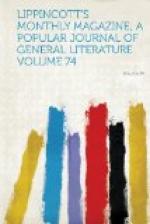The flanks of these mountains, however, were really of importance to the botanical motive of the expedition. Along the side of the Camanti, where the yellow Garote leaked downward in a rocky ravine, the Bolivians were again successful. They brought to Marcoy specimens of half a dozen cinchonas, for him to sketch, analyze and decorate with Latin names. The colors of two or three of these barks promised well, but the pearl of the collection was a specimen of the genuine Calisaya, with its silver-gray envelope and leaf ribbed with carmine. This proud discovery was a boon for science and for commerce. It threw a new light upon the geographical locality of the most precious species of cinchona. It was incontestably the plant, and the Bolivians appeared amazed rather than pleased to have discovered outside of their own country a kind of bark proper only to Bolivia, and hardly known to overpass the northern extremity of the valley of Apolobamba. This discovery would rehabilitate, in the European market, the quinine-plants of Lower Peru, heretofore considered as inferior to those of Upper Peru and Bolivia. The latter country has for some time secured the most favorable reputation for its barks—a reputation ably sustained by the efforts of the company De la Paz, to whom the government has long granted a monopoly. This reputation is based on the abundance in that country of two species, the Cinchona calisaya and Boliviana, the best known and most valued in the market. But for two valuable cinchonas possessed by Bolivia, Peru can show twenty, many of them excellent in quality, and awaiting only the enterprise of the government and the natural exhaustion of the forests to the south.
This magnificent bit of luck, the finding of the calisaya, awakened in the susceptible bosom of Mr. Marcoy an ardent desire to explore for himself the site of its discovery. But Eusebio, the chief of the cascarilleros, assuming a mysterious and warning expression, informed the traveler that the place was quite inaccessible for a white man, and that he had risked his own neck a score of times in descending the ravine which separated the route from the hillside where the fortunate plants were growing. He promised, however, to point out the locality from afar, and to show, by a certain changeable gloss proper to the leaf, the precise stratum of the calisaya amongst the belts of the forest. This promise he forgot to execute more particularly, but it appeared that the locality would never be excessively hard to find, marked as it was by Nature with the gigantic finger-post of Mount Camanti. Placing, then, in security these precious specimens among their baggage, the explorers continued their advance along the valley.




